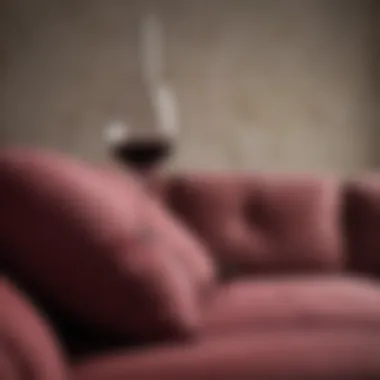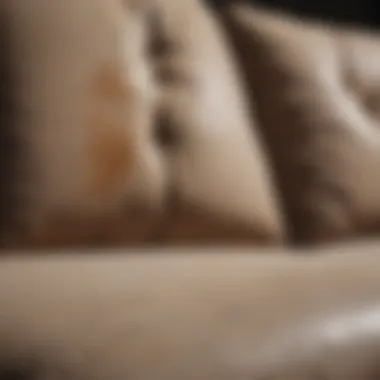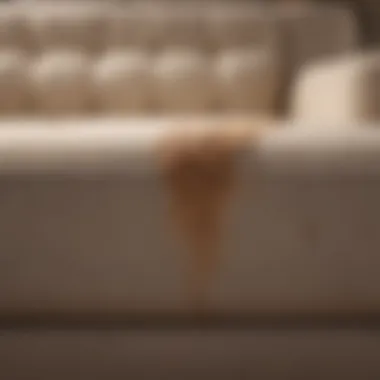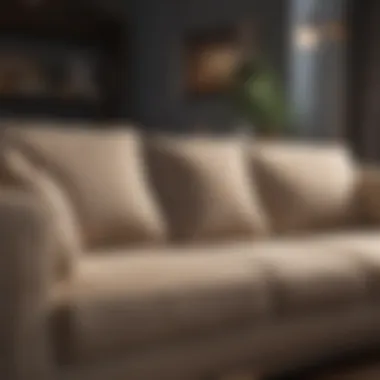Effective Techniques for Stain Removal from Couches


Intro
Couches covered in fabric can add a touch of comfort to any living space. They are often the centerpiece of our lounges, where family gather and memories are made. However, the inevitable stains can mar this centerpiece and shift the vibe of the room from inviting to overwhelming. Grappling with stains isn’t just about aesthetics; it can impact the longevity of your furniture. Tackling the challenge with practical knowledge can keep your fabric couches looking new. This article aims to equip you with effective techniques for stain removal while maintaining the integrity of your cherished furniture.
To navigate the stains that may plague your couch, it’s essential to identify common culprits. Food and drink spills, pet accidents, and everyday wear and tear are just a few of the key offenders. Knowing your enemy is half the battle. So, let’s dive into how to fight back effectively.
Understanding Common Stains
Every couch has a story, and sometimes those stories come with a few blemishes.
- Food and Drink: Grease from chips or the splash of tomato sauce during a family movie night can leave a mark.
- Pet Accidents: Pets introduce joy but, let's face it, their accidents are a whole different ball game.
- Ink Stains: A spilled pen can feel like a disaster, especially on light fabric.
- Mud and Dirt: From shoes trekking across the room to little ones on the go, dirt finds its way onto our beloved couches.
Understanding these common stains is vital for choosing the appropriate removal technique.
Essential Cleaning Materials
Having the right tools can make all the difference. Here’s a handy list:
- Mild Detergent: A gentle soap that won't harm fabric fibers.
- White Vinegar: A dual-purpose agent, acts as both a cleaner and deodorizer.
- Baking Soda: Useful for absorbing odors rather than just cleaning.
- Clean Cloths: Microfiber cloths work well to avoid lint.
- Spray Bottles: Perfect for mixing solutions and applying them effectively without soaking.
The right materials aren’t just preferences; they’re necessities for effective stain removal.
Step-by-Step Stain Removal Techniques
Now, let’s break it down into actionable steps. Each stain requires a tailored approach.
Food and Drink Stains
- Act Fast: The sooner you address it, the better the outcome.
- Blot, Don’t Rub: Use a cloth to blot the area, soaking up as much as possible.
- Prepare a Cleaning Solution: Mix mild detergent with water.
- Apply: Dab the solution onto the stain with a cloth.
- Rinse: Use another cloth dampened with clean water to rinse the area.
- Dry: Press a dry cloth against the wet area to absorb moisture.
Pet Stains
- Clean the Area Thoroughly: If it’s urine, soak up the liquid first.
- Use Vinegar Solution: Mix equal parts vinegar and water, then apply.
- Sprinkle Baking Soda: After applying the vinegar solution and letting it sit, make a dusting of baking soda to absorb odors.
Ink Stains
- Test First: Make sure the solution doesn’t discolor your fabric.
- Apply Rubbing Alcohol: Using a cotton ball, gently dab at the ink stain, taking care not to spread it.
Mud and Dirt
- Let it Dry: Allow the mud to dry completely before attempting removal.
- Brush Off: Gently brush off excess dirt with a soft brush.
- Spot Clean: Use a mixture of water and detergent and softly scrub the area with a cloth.
Tip: Always test your cleaning solutions on a hidden area first to avoid damaging your fabric.
Preventive Measures
Keeping stains at bay often means creating a proactive strategy. Here are some preventive tips:
- Regular Maintenance: Vacuum your couch weekly to prevent build-up of dirt and dust.
- Use Fabric Protectors: Applying a fabric protector can provide an extra layer of defense against stains.
- Immediate Attention: Always address spills immediately to prevent them from setting in.
End
Maintaining the fabric couch in your home doesn’t have to be a daunting task. With the right techniques and a tad of elbow grease, those pesky stains can be mirrored back off into the ether. Keeping your fabric seating fresh and clean not only enhances your living space but preserves the integrity of your furniture for years to come. Remember, every stain has a solution!
Understanding Your Fabric Couch
When it comes to maintaining the cleanliness and longevity of your fabric couch, having a solid understanding of the fabric type you own is crucial. Each fabric has its own set of characteristics, and knowing these can make all the difference when tackling stains. This segment digs into why fabric comprehension is vital and the benefits it brings to your cleaning efforts.
Different Types of Fabric
Couches come in various fabric types, each with its own unique qualities. For example, cotton is soft and breathable, offering comfort but is prone to stains due to its absorbent nature. On the other hand, polyester is often favored for its durability and stain resistance, making it suitable for homes with kids or pets.
Here's a brief overview of some common fabric types:
- Cotton: Popular for its comfort but can be a magnet for spills. Washing often helps but may fade over time.
- Polyester: Resilient and easy to clean, this fabric resists stains better than cotton but can be less breathable.
- Linen: Elegant and natural, linen gives a sophisticated look but wrinkles easily and is not very stain-resistant.
- Microfiber: Made from synthetic fibers, microfiber is excellent at repelling stains and spills, making it a good choice for high-traffic areas.
Each type not only affects how a sofa looks, but also its cleaning requirements and stain resistance.
Stain Resistance of Fabric Types
Understanding how different fabrics react to stains is equally important. Some fabrics, like microfiber, are engineered to resist stains and repel liquids, making accidental spills less of a headache. Conversely, cotton and linen can absorb stains quickly, which means immediate action is key.


The stain resistance of your couch fabric can dictate how you clean it and what cleaning solutions to use. For instance:
- Microfiber typically allows for simple soap and water cleaning methods.
- Cotton might need specialized detergents targeted toward eliminating set-in stains.
- Leather (while it’s technically not a fabric, often included with upholstered items) can require conditioning treatments to maintain its finish after stains are treated.
This knowledge can not only save you time in cleaning but also prevent potential damages. Generally, knowing the fabric type helps you to establish a cleaning routine and identify appropriate cleaning agents. This proactive approach goes a long way in preserving the longevity of your fabric couch.
"Dirt that remains on your fabric can set in and make the cleaning job ten times harder. Knowing your couch type helps in acting promptly and wisely!"
Types of Common Stains on Fabric Couches
Understanding the various types of stains that can afflict fabric couches is crucial for maintaining their pristine appearance and longevity. Each type of stain presents its own set of challenges, requiring tailored approaches to removal. This knowledge not only helps you in keeping your furniture looking its best but also extends its lifespan, making it a valuable insight for anyone who cherishes their living space. Here’s why knowing these stains matters:
- Preventive Measures: By recognizing common stains, you can take proactive steps in protecting your couch.
- Technique Tailoring: Different stains require different removal techniques; knowing what you're dealing with helps you choose the right method.
- Material Awareness: Understanding how different fabrics react to certain stains can save you from accidental damage during cleaning.
Food and Beverage Stains
Food and beverage stains rank among the most frequent culprits when it comes to couch accidents. A sudden spill at dinner or a mishap with a wine glass can leave your fabric couch looking worse for wear. Examples include red wine, sauces, and coffee. The key to dealing with these kinds of stains is to act fast.
- Immediate Action: As soon as you notice a stain, gently blot it with a clean cloth. Rubbing can spread the stain and push it deeper into the fabric.
- Treatment Method: Use a solution of mild soap and warm water to help lift the stain. Apply it gently and blot dry. Don’t oversaturate the fabric, as too much moisture can lead to mold.
Ink and Dye Stains
Ink and dye stains can be particularly tricky due to their vibrant colors and long-lasting nature. It might be a ballpoint pen that leaked, or maybe a stray mark from a fabric dye project gone awry. The critical step here is identifying the ink type as it often determines the cleaning approach you’ll need.
- Identifying Ink Type: Water-based inks are easier to manage compared to oil-based inks.
- Cleaning Approach: For water-based inks, you can use isopropyl alcohol; for oil-based, consider specialty cleaners. Always test on a hidden area first to ensure the fabric won’t be damaged.
Grease and Oil Stains
Grease and oil stains are common in households where cooking is prevalent. You might find these stains from food cooking splatters or even from pet accidents. These require a bit of finesse as grease can easily set into fabric.
- Blotting Technique: Immediately blot to absorb the oil. Avoid rubbing as this will make it worse.
- Cleaning Solution Application: A mild dish soap mixed with warm water can work wonders; applying it with a cloth should start to lift the stain.
Pet Stains
For pet owners, few things are more daunting than a stain from a beloved furry companion. Urine, vomit, or fur can all make their way onto fabric couches. Addressing these stains promptly is essential to prevent lingering odors and stains.
- Immediate Clean-Up: Quick action is key here. Blot up liquid stains with paper towels to absorb as much as possible.
- Deodorizing Process: After cleaning, using a vinegar and water solution can help neutralize odors, followed by a thorough rinse with cloth and clean water.
General Dirt and Dust
Everyday life brings a host of dirt and dust that can build up on fabric couches over time. Neglecting general upkeep can lead to these elements becoming embedded in the fabric, dulling its appearance.
- Regular Maintenance: Vacuuming regularly can help keep dust at bay. This step is critical for maintaining both aesthetic and hygiene.
- Deep Cleaning Method: Every now and then, using a steam cleaner specifically designed for upholstery can give your couch a fresh lease on life by lifting ground-in dirt.
Maintaining awareness around the types of stains and taking immediate action can significantly help in preserving the integrity of your fabric couches.
Essential Supplies for Stain Removal
Before diving into the nitty-gritty of how to tackle those pesky stains on your fabric couch, it’s imperative to understand the essential supplies necessary for effective stain removal. Having the right tools and cleaning agents on hand can mean the difference between a successful clean-up and a failure that leaves you frustrated.
The tools and products you gather should serve a dual purpose: effectiveness and gentleness. You want to eliminate stains without damaging your couch’s fabric or altering its colors. So, whether you prefer commercial products or concocting your own solutions at home, knowing what works best is crucial.
Cleaning Agents
Cleaning agents are the bread and butter of stain removal. They break down the composition of stains, helping to lift them from the fabric. When selecting a cleaning agent, consider how it caters to different types of stains and the fabric of your couch.
Commercial Stain Removers
Commercial stain removers are specifically formulated for tackling a variety of stains, ranging from food spills to ink marks. One significant aspect of these products is their convenience; they come ready-to-use from the bottle, which is a definite plus for the time-strapped individual.
This cleanliness ambition, however, doesn't come without a caveat. You need to be cautious with their usage as some may contain harsh chemicals that can damage delicate fabrics. Generally, commercial stains removers have the advantage of being specially designed for certain types of stains. For example, some might work wonders on grease but be ineffective for dye stains. Thus, always check the label or do a quick online search for reviews specific to your fabric type before diving in.
Homemade Solutions
There’s growing interest in homemade solutions as people are becoming more aware of potential allergens or chemicals in commercial cleaners. These solutions often use common household items like baking soda, vinegar, or dish soap, making them cost-effective and environmentally friendly.
A standout feature of homemade cleaners is that you have control over the ingredients, which can be a real game changer for those with sensitive skin or allergies. However, one must be cautious: not all stains respond well to DIY remedies. It’s worth experimenting to find the right mix, but proceed carefully to ensure you don’t inadvertently set a stain or damage the fabric.
Tools Needed
Equally as important as cleaning agents are the tools you'll need. The effectiveness of any stain removal attempt largely hinges on the quality of the tools in hand. Two main factors play a role in their selection: durability and gentleness to guarantee they don’t scratch or harm your couch.


Cloths
When it comes to stain removal, soft cloths are a must-have. Their primary role is to absorb moisture and lift stains without leaving lint or scratches behind. Microfiber cloths are particularly popular because they’re highly absorbent and can pick up tiny dirt particles, making them effective for both cleaning and drying.
However, always ensure the cloth is clean before use; otherwise, you’ll end up transferring more dirt into the stain you’re trying to remove.
Sponges
Sponges also play a vital role in the cleaning process, especially for lifting stains that are more embedded into the fabric. They can hold more liquid than a cloth and offer a scrubbing capability that is gentle enough not to cause damage.
However, one must be wary of using a sponge that’s too coarse, as it might risk fraying or pulling at the fabric threads. Choosing the right sponge can be a learning process, often requiring some trial-and-error.
Brushes
Finally, brushes come in handy for deeper cleans or for treating more stubborn stains that need some extra elbow grease. A soft-bristled brush is excellent for agitating cleaner agents into the fabric without damaging delicate fibers.
Nevertheless, it’s critical to remember that not all fabrics can withstand brushing. A good rule of thumb is to test an inconspicuous area first; if all goes well, you’re in the clear.
"Having the right tools makes all the difference. Not just for removing stains, but also for maintaining the overall integrity of your couch."
In the end, gathering the right supplies—whether commercial or homemade—along with appropriate tools like cloths, sponges, and brushes sets the foundation for successful stain removal. The path to a cleaner fabric couch is paved with preparation and understanding, ensuring you tackle each job with confidence.
Step-by-Step Stain Removal Techniques
Removing stains from fabric couches can feel like an uphill battle, but the right techniques can make it a walk in the park. The focus on step-by-step methods not only simplifies the process, but it also ensures that even the toughest stains have a high likelihood of being conquered. By dissecting the cleaning process into manageable chunks, one can adopt a systematic approach which leads to success.
When you tackle stains methodically, you not only preserve the integrity of your couch but also extend its lifespan. In this section, various stain types will be addressed with clear, actionable steps that make use of readily available materials and techniques. Let's dive into the specifics of dealing with different kinds of stains.
Food and Beverage Stains
Immediate Action
The initial response to a stain can make all the difference. The sooner you act, the better your chances are of completely removing the stain. This immediate action is critical because it helps prevent the stain from setting in. The key characteristic of this approach is not just speed but also the appropriateness of the method used.
One unique aspect of immediate action is its simplicity. Using a cloth to blot is often all that's needed at first. However, there's a caveat; if you rub instead of blot, you could spread the stain even more. The main advantage? This technique is common sense—most people know that acting quickly is usually the best approach. However, distractions or overconfidence may interfere, leading to mistakes that could cost you a clean couch.
Treatment Method
Once you've acted quickly, the next step is what you could call the “treatment method.” This includes applying a suitable cleaning solution tailored to the type of food or beverage stain you’re dealing with. Whether it be wine, coffee, or something else, understanding the correct solution is essential.
The key characteristic of the treatment method is its adaptability. Depending on the stain's nature, you might consider a commercial cleaner or a homemade solution, like a mix of dish soap and water. What's great about this approach is that it often leads to visible results, boosting your confidence in the cleaning process. However, improper use could lead to further staining or damage to the fabric, so always do a patch test first!
Ink and Dye Stains
Identifying Ink Type
Diving into ink stains can feel like sleuthing for clues. The first step is understanding which type of ink you’re dealing with. This aspect is crucial because various inks require different cleaning solutions. For instance, water-based inks may lend themselves to simpler treatments compared to oil-based ones.
Identifying ink type is a beneficial choice as it allows for targeted approaches. If you mistakenly assume an ink type, you might end up with a larger mess on your hands. The unique feature here is the potential for tailored solutions, increasing the effectiveness and efficiency of your cleaning strategy. But, if you're not familiar with this type of task, figuring out the ink type could be daunting.
Cleaning Approach
After identifying the ink, it's time for the cleaning approach. This method often involves applying isopropyl alcohol or vinegar, depending on the ink type established in the previous step. The beauty of this approach lies in its potential for success when performed correctly.
What stands out here is its reliance on commonly found household items, making it convenient for most. However, one must be cautious. Unsuitable application, like using too much liquid, could damage the fabric. It's a balancing act between effective cleaning and preserving the couch's fabric.
Grease and Oil Stains
Blotting Technique
In the world of grease and oil, one of the best friends you have is the blotting technique. This simple action involves placing a clean cloth over the stain and applying just enough pressure to absorb the grease without pushing it deeper into the fabric.
This technique is particularly advantageous because it minimizes damage to the fiber while maximizing stain removal. The unique element here is the effectiveness of controlling the blotting process, enabling you to manage how much grease is absorbed and when to change the cloth. The downside is that if left unattended, the stain can spread before you even get the chance to apply the technique.
Cleaning Solution Application
Once you've absorbed what you can, the next step is selecting an appropriate cleaning solution to lift the remaining oil. Many people rely on solutions such as baking soda or dish soap mixed with warm water. This step is crucial because it comprehensively targets the stain.
The main characteristic of this strategy is its versatility—different solutions work on different types of grease. Its unique feature is often found in using items that most already have at home, making this approach both practical and financially efficient. However, an unmeasured application might saturate the fabric, creating more issues than it solves.
Pet Stains


Immediate Clean-Up
Pet parents, unfortunately, know that accidents happen. Immediate clean-up is crucial when dealing with pet stains to prevent odors and further damage. It involves first blotting with paper towels before applying any cleaning agents.
The notable quality of this method is that it minimizes the stain's presence before it becomes an unwelcome guest in your fabric couch. Plus, the catch-22 is that if the clean-up isn’t done quickly enough, you're left with a stain that could linger long-term, often leading to a permanent mark.
Deodorizing Process
Once the visible stain is addressed, the next step is deodorization. Using baking soda sprinkled on the area can be effective. This process helps tackle any remaining odors, leaving the couch smelling fresh again.
The essence of the deodorizing process lies in its simplicity. Unlike more complex cleaning solutions, it often only involves a sprinkling and vacuuming later. The only con? Some may overlook this step, thinking it's unnecessary, when in fact, odors can earn a permanent residence in your fabric if ignored for too long.
General Dirt and Dust
Regular Maintenance
Dirt and dust are like that uninviting party crasher that you never want to deal with. Regular maintenance entails vacuuming your couch a couple of times a week to prevent debris from settling deep into the fabric.
A pivotal characteristic of this method is its proactive nature; you're preventing stains and dirt from gaining a stronghold. A unique feature here is that a simple vacuum can make a world of difference. The downside? It’s easy to put off. Many people think that damage only comes from direct stains, but neglect could be as damaging over time.
Deep Cleaning Method
When regular maintenance isn't enough, a dedicated deep cleaning can revive your couch. This typically involves a steam cleaner or a fabric-safe cleaner to resolve embedded dirt. The deep-cleaning method gives your fabric the TLC it deserves, leaving it not just clean but also rejuvenated.
The standout aspect of this approach lies in its comprehensiveness—it not only clears dirt and stains but also refreshes the material. One downside might include the time it takes to perform compared to regular cleaning, but the end result often proves well worth it.
In the quest for a spotless fabric couch, understanding the nuances of stain removal is your secret weapon. Act promptly, use the right techniques, and keep your living space fresh and inviting.
Final Touches and Maintenance Tips
In the grand scheme of keeping your fabric couch pristine, the little things often make a world of difference. Just as a well-tailored suit looks complete with the right accessories, your couch requires its own final touches. These maintenance tips not only prolong the life of your upholstery but also keep it looking fresh and welcoming. Whether it’s through proper drying methods post-cleaning or adopting regular upkeep habits, these practices contribute significantly to the overall health of your couch.
Drying Techniques
After stain removal, proper drying techniques stand as a crucial part of the cleaning process. Not only does wet fabric have a higher chance of developing mold or mildew, but it can also lead to an unappealing odor. When you deal with stains, it’s tempting just to rub them out and call it a day, but allowing the fabric to dry correctly is non-negotiable.
To ensure your couch dries effectively, consider the following steps:
- Air Drying: Whenever possible, let the fabric air dry naturally. This method allows moisture to escape gradually, minimizing distortion in the fibers.
- Circulation: If you have the means, position a fan nearby or open windows to foster airflow around the fabric. Good ventilation can speed up the drying process without harming the material.
- Absorption: Use clean, dry towels to blot up any excess moisture after cleaning. These towels can help absorb what air circulation might not clear up quickly enough.
Protecting Your Fabric Couch
Maintaining the integrity of your fabric couch requires foresight. While we can’t control every spill or mishap, taking a proactive approach can stave off potential issues down the line.
Use of Fabric Protector
Fabric protectors are a popular choice among couch owners. These substances create a protective barrier on your upholstery, making it more resistant to stains and everyday wear and tear. The main characteristic of fabric protectors is the invisible shield they form, which can repel spills before they become a full-blown mess.
One unique feature of most fabric protectors is that they usually don't alter the original color or texture of the fabric. This means you get peace of mind without compromising style. However, it’s essential to remember that not all fabric protectors are created equal—some may be more suited for certain fabric types than others. The main advantage here is the preventative nature of these products—once applied, you’ll find it easier to clean up minor stains while maintaining your couch’s overall appearance.
Regular Vacuuming
It sounds simple, but regular vacuuming is often overlooked yet fundamental to couch maintenance. Dust and crumbs don’t just make a couch look bad; they can also break down the fibers over time. A key aspect of regular vacuuming is that it removes the particles that, if left unchecked, become embedded in the fabric and are much harder to deal with later on.
Typically, using an upholstery attachment on your vacuum cleaner works wonders in reaching into the crevices and seams where dirt likes to hide. Regular maintenance also means setting a schedule—be it weekly or biweekly—so that this task doesn’t fall by the wayside. The major advantage is a significantly cleaner couch, which not only looks better but also is more inviting to sit on.
"An ounce of prevention is worth a pound of cure"—in couch maintenance, this couldn't be truer. Regular cleaning and protective measures can save an extensive amount of effort later on.
By embracing these final touches and maintenance tips, your fabric couch will not only withstand the test of time but become a central, clean, and cherished part of your living space.
When to Call Professionals
When it comes to tackling stubborn stains on fabric couches, there’s a fine line between do-it-yourself remedies and the need for professional intervention. Understanding when to call professionals can save you both time and potential damage to your beloved furniture. Certain stains, if left untreated or handled incorrectly, can set in or worsen, leading to more significant problems.
Identifying Severe Stains
Severe stains are not just your average spills; they are often deeply embedded in the fabric fibers, resisting your best at-home cleaning efforts. Here are some signs that you may indeed be facing a severe stain:
- Discoloration: If the area appears discolored and the stain has spread, it may require specialized cleaning agents that you might not have at home.
- Odors: Unpleasant smells, especially from pet accidents or food spills, can linger long after the visible stain is treated. Persistent odors can indicate mold growth or deeper cleaning issues.
- Texture Change: If the fabric feels crispy, sticky, or significantly different at the stain's location, that could be a red flag.
- Fading: If the color of the fabric is fading around the stain from excessive scrubbing, it’s a clear sign to stop and consider professional help.
If your couch shows any of these symptoms, it might be wise to consult someone who specializes in upholstery cleaning. They will know the best approaches and products to employ, ensuring your fabric remains intact and looks as good as new.
Advantages of Professional Cleaning
There are various benefits to engaging professionals for stain removal, not all of which may be immediately obvious. Here are a few key advantages:
- Expert Knowledge: Professionals are experienced in identifying different fabric types and the most effective cleaning techniques for each. They understand the chemistry of stains and can apply the most suitable solutions without damaging the fabric.
- Specialized Equipment: Many cleaning services use high-grade equipment that's not available to the general public. These machines can extract stains from deep within the fibers that typical home remedies simply cannot reach.
- Time-Saving: DIY cleaning can often be time-consuming and not always successful. Hiring a professional allows you to sit back while they handle the intricate work, freeing up your time for more important tasks.
- Satisfaction Guarantee: Many professional services offer satisfaction guarantees. If the stains do not come out to your standards, they may return to re-evaluate and re-treat the furniture without extra charge.
Therefore, while tackling minor stains on your fabric couch is entirely achievable, don’t hesitate to reach out for expert assistance when the situation calls for it. Investing in professionals can preserve the beauty and longevity of your cherished couch and save you a lot of headache in the long run.



